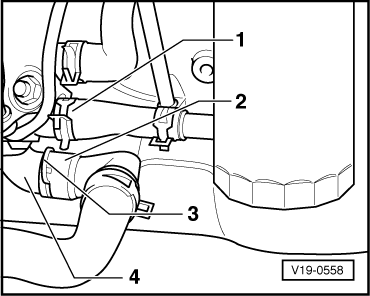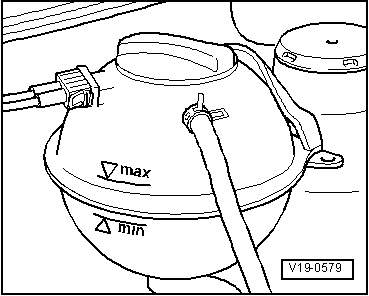-
‒ →
Pull out retaining clip -3-, pull connection -2- off thermostat flange -4- and pull off coolant hose -1- or remove thermostat flange -4-.
If the cooling system was filled with G 11 anti-freeze -coloured green-:
-
‒ Before refitting the coolant hose or flange and filling with new anti-freeze G 12 -coloured red-, the cooling system must be flushed out.
-
‒ Remove as much of the coolant remains as is possible from the cooling system. To do this e.g. blow compressed air into the coolant expansion tank.
-
‒ Close cooling system and top with with pure water.
-
‒ Run engine at idling speed for approx. 2 minutes.
-
‒ Drain off coolant and blow out the cooling system again with compressed air.
Note:
Observe disposal regulations!
Filling
Notes:
-
◆ Coolant additive:
▸ approx. 06.96 G11 -coloured green-
07.96 ▸ G 12 -coloured red-
-
◆ When refilling the coolant system only use G 12.
-
◆ The frost and corrosion protection additive G 11 must only be used for topping-up purposes, when the cooling system is still filled with G 11.
Identification: Green in colour
-
◆ On no account must G 12 be mixed with other coolant additives!
Warning!
On no account must the coolant additives -G 11- and -G 12- be mixed. If these additives are mixed it will cause serious engine damage.
-
◆ If the fluid in expansion tank is brown, G 12 has been mixed with other coolant. In this case the coolant must be changed.
-
◆ G 12 (G 11) and coolant additives marked "In accordance with TL VW 774 D (C)" prevent frost and corrosion damage, scaling and also raise boiling point of the coolant. For this reason the system must be filled all year round with frost and corrosion protection additives.
-
◆ Particularly in countries with tropical climates, the coolant due to the higher boiling point improves engine reliability when heavily loaded.
-
◆ Protected against frost to about -25 °C (in arctic climatic countries to about -35 °C).
-
◆ The coolant concentration must not be reduced by adding water even in warmer seasons and in warmer countries. The anti-freeze ratio must be at least 40 %.
-
◆ If for climatic reasons a greater frost protection is required, the amount of G 12 can be increased, but only up to 60 % (frost protection to about -40 °C), as otherwise frost protection is reduced again and cooling effectiveness is also reduced.
-
◆ If radiator, heat exchanger, cylinder head or cylinder head gasket is replaced, do not reuse old coolant.
Recommended mixture ratios:
|
Frost protection to
|
Anti-freeze amount
|
G 121)
|
Water1)
|
|
-25 °C
-35 °C
|
40 %
50 %
|
2.4 ltr.
3.0 ltr.
|
3.6 ltr.
3.0 ltr.
|
1)
The quantity of coolant can vary depending upon the vehicle equipment.
-
‒ Press down top radiator hose.
|


